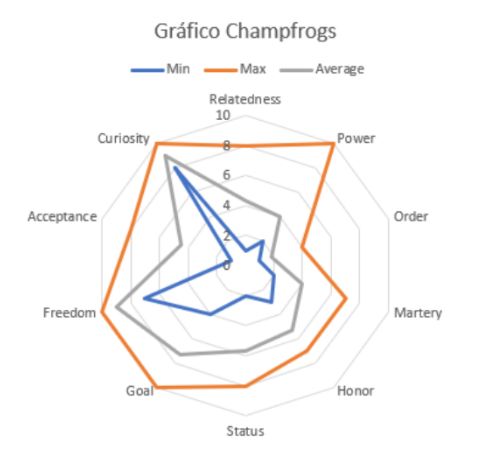Motivation Diagnosis
Jul 19, 2021
Motivating teams is probably one of the hardest tasks any Manager has to deal with.
Motivation is never constant and, in this sense, it is necessary to constantly assess the motivations of employees.
According to Herzberg the motivating factors are:
- Intrinsic - It is determined by internally generated factors that cause people to behave in one way or another, or to move in a certain direction;
- Extrinsic - It is generated by factors external to the person, such as: rewards, salary increases, prizes or promotions;
For Intrinsic Motivation, Management 3.0 thinker JurgenAppelo created the CHAMPFROGS Moving Motivators tool, for which he studied the work of Daniel Pink, Steven Reiss and others, and identified 10 motivating factors that can be positive or negative and that can influence people at work.
The word CHAMPFROGS doesn't mean anything, it's just an acronym to remind ourselves of the ten levels of motivation, but the tool itself is great for helping to identify what really motivates and engages teams.
- Curiosity – Being motivated by having too many things to investigate or think about;
- Honor – Being motivated by a sense of pride that your personal values are reflected in your work;
- Acceptance – Being motivated by receiving approval from who you are and what you do from the people around you;
- Mastery – Being motivated when your work challenges your skills, but within your abilities;
- Power – Being motivated by having an influence on what is happening around you;
- Freedom – Being motivated by being independent from others with your own responsibilities;
- Relatedness – Being motivated by having a good relationship with your colleagues and/or customers;
- Order – Being motivated by having enough rules (but not too many) to create a stable work environment;
- Goal – Being motivated by discovering that your (self-identified) goal in life is reflected in the work you do;
- Status – Being motivated by the position you occupy and the recognition you receive from others;
The implementation of CHAMPFROGS in the context of an organization can be done in the scope of recruitment, socialization and/or evaluation processes through the ordering of the cards from the most important to the least important.
Once the ordering has been established, a table with the classification given by each employee can be created. Then determine the minimum, maximum and average of the group and make a radar chart with these values so you can easily analyze them.

For extrinsic motivations, we can use the SIBS tool. The word SIBS is just an acronym to remind us of the 4 levels of extrinsic motivation:
- Salary
- Incentives (Short term and medium/long term) – such as commissions, bonuses, travels or equity in the company;
- Benefits - Social Benefits: Aims to meet primary needs (food, health and education) and security needs (illness, disability, death). Specific Benefits: Car Plan, Capitalizable Life Insurance
- Status Symbol – External signs of the importance that companies give to employees with the aim of increasing their self-esteem and consolidating their sense of self-fulfillment.
In the context of an organization, the implementation of SIBS can start with, in the recruitment process, asking for the desired salary, the benefits that can be awarded, etc.
At a later stage, implement one or several components that make up the SIBS, depending on the employee's performance.
In this way, through CHAMPFROGS and SIBS, managers can create conditions that will maximize the possibility of employees being motivated at work.
Ricardo Diz
Consultant
